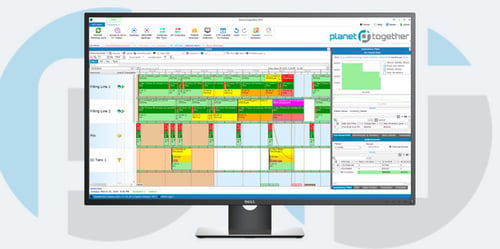
Optimizing Pharmaceutical Supply Chains for Sustainability and Resilience in 2025
In 2025, pharmaceutical manufacturing continues to face unprecedented pressures—from climate-related disruptions and supply shortages to increasingly complex regulatory requirements and evolving consumer expectations. For Plant Managers striving to deliver operational efficiency while also meeting sustainability and resilience goals, the need for smarter, integrated supply chain planning has never been more urgent.
This blog explores how pharmaceutical manufacturers can optimize their supply chains for both sustainability and resilience by integrating Advanced Planning and Scheduling (APS) systems like PlanetTogether with ERP platforms such as SAP, Oracle, Microsoft Dynamics, Kinaxis, or Aveva. By creating a more adaptive, eco-conscious, and connected production environment, Plant Managers can gain the agility and transparency needed to thrive in a dynamic global landscape.
The New Operating Environment: Why Resilience and Sustainability Must Converge
In the past, sustainability and resilience were often treated as separate goals. Today, they are fundamentally intertwined. A sustainable supply chain is not just environmentally responsible—it’s also less exposed to risk. Localized sourcing reduces dependency on global logistics; circular waste strategies reduce raw material needs; predictive planning cuts down on costly inefficiencies. All of these outcomes make operations more adaptable and secure.
Pharmaceutical manufacturing, in particular, faces a unique set of vulnerabilities:
Strict regulatory oversight
Delicate cold chain logistics
Sensitivity to raw material quality
Growing pressure to reduce carbon emissions
The result is a high-stakes balancing act that demands innovation at the intersection of supply chain management, sustainability strategy, and real-time production control.

Mapping the Path to Sustainable and Resilient Supply Chains
To optimize your supply chain in 2025, Plant Managers must evaluate sustainability and resilience in parallel. Here are the key dimensions to consider:
Carbon-Conscious Planning
Scope 1, 2, and 3 emissions are now central to pharmaceutical ESG reporting. Manufacturers must reduce their footprint by:
Localizing suppliers
Using green transportation methods
Reducing energy waste in production
Minimizing overproduction and spoilage
Supplier Diversification and Transparency
Depending on single-source suppliers—especially overseas—has proven dangerous in recent years. Manufacturers must pivot toward:
Multi-sourcing strategies
Regionalized supplier networks
Supplier ESG scoring and compliance tracking
Inventory Optimization with Resilience in Mind
Too much inventory increases waste and carbon impact; too little leads to shortages and compliance risks. The key lies in:
Real-time planning with predictive analytics
Dynamic safety stock adjustments
APS-driven visibility into demand and constraints

The Role of PlanetTogether APS in Driving Integration and Agility
Traditional ERP systems offer a solid foundation for enterprise resource planning, but they lack the advanced algorithms and scheduling flexibility needed for true supply chain optimization.
That’s where PlanetTogether APS comes in—integrating seamlessly with platforms like SAP, Oracle, Microsoft, Kinaxis, and Aveva to deliver advanced, real-time production planning that aligns with both resilience and sustainability objectives.
Key Benefits of PlanetTogether Integration for Plant Managers:
Real-Time Decision Intelligence
APS integration provides instant visibility into bottlenecks, energy consumption, labor capacity, and material availability. Plant Managers can simulate production scenarios that balance carbon impact, cost, and service levels.
Dynamic Scheduling for Sustainability
Through what-if analysis and constraint-based scheduling, APS systems like PlanetTogether allow you to:
Schedule batches for energy efficiency
Optimize cleaning cycles to reduce water/chemical waste
Group orders to reduce transportation emissions
Supplier Synchronization
When integrated with ERP systems like SAP or Kinaxis, PlanetTogether can tap into supplier performance data and lead time variability, enabling Plant Managers to:
Shift demand dynamically based on disruption signals
Reduce material obsolescence and expiration
Build a greener, more adaptive procurement plan
Compliance and Traceability
Sustainability isn't just about carbon—it's about traceability, too. PlanetTogether enables compliance reporting on:
GHG emissions
Material source traceability
Audit readiness through clean digital documentation

Key Integration Points Between APS and ERP Platforms
To unlock the full potential of your supply chain, the following integration points are crucial:
| APS Functionality (PlanetTogether) |
ERP Data Source (SAP/Oracle/Kinaxis/etc.) |
| Material availability and constraints |
Master data, BOMs, inventory balances |
| Labor and equipment scheduling |
Work centers, shift calendars |
| Supplier lead times and disruptions |
Purchase orders, vendor ratings |
| Sustainability metrics |
Emissions data, audit trails, certifications |
| Order prioritization and changeovers |
Sales orders, customer allocations |
These connections enable a continuous feedback loop where your APS can make intelligent decisions grounded in real-time business context.
The 2025 Imperative: Taking Action as a Plant Manager
As a Plant Manager, you sit at the intersection of operations, compliance, and strategic execution. In 2025, staying competitive means championing supply chains that are both environmentally responsible and operationally agile.
Here’s how to get started:
Conduct a Sustainability and Resilience Readiness Audit
Identify where your current planning systems fall short in terms of adaptability, waste, and emissions impact.
Align APS Goals with Corporate ESG Objectives
Work with your sustainability team to define measurable targets (e.g., energy per unit output, waste reduction rates, supplier ESG benchmarks).
Integrate PlanetTogether with Your ERP System
Collaborate with IT to enable bi-directional data sharing between PlanetTogether and SAP, Oracle, Microsoft, Kinaxis, or Aveva. Ensure the integration supports both operational planning and ESG reporting.
Train Planners on Sustainable Scheduling Practices
Empower your planning team to utilize PlanetTogether’s scenario modeling tools to test sustainable scheduling alternatives.
Continuously Optimize with Data
Use dashboards and KPI trackers to monitor CO₂ output, inventory turnover, yield variability, and supplier compliance in real time.
Optimizing pharmaceutical supply chains for sustainability and resilience isn’t a future ambition—it’s a 2025 requirement. Regulatory pressure, investor expectations, and patient demands are converging. Plant Managers must take the lead in transforming operations through integrated planning tools that offer both environmental and operational intelligence.
By combining PlanetTogether APS with robust ERP platforms like SAP, Oracle, Microsoft, Kinaxis, or Aveva, pharmaceutical manufacturers can create supply chains that are not just efficient—but agile, compliant, and future-ready.
Are you ready to take your manufacturing operations to the next level? Contact us today to learn more about how PlanetTogether can help you achieve your goals and drive success in your industry.